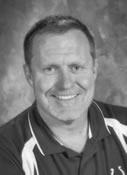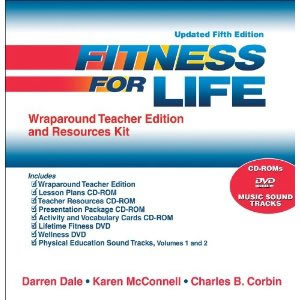MEDIA
REVIEW
Two years ago I had the paper edition
of the book Fitness
for Life, or at least I had it in my possession for about
a week. I think I found this book rooting around in the old
P.E. Teacher's closet where it had fallen by the wayside.
It was a great book, if I recall. I loaned it to one of my
students who was moving, and was worried about her arm which
she'd broken three times in three years. Feeling bad, I handed
over the book. I hope she got more out of it than I did.
So now I'm reviewing this massive
volume, and it was difficult to do without the companion book,
now up to the 5th edition, so the first thing I'd recommend
is having the text
to refer to. They go hand in hand like peanut butter and jelly.
This is one comprehensive volume.
It contains the ancillaries and extras the original text doesn't
have, allowing the book to essentially be taught almost year-round;
incorporating "fitness" as one of the foundational
underpinnings of your established program. There are thumbnails
of portions taken directly from the text, and lesson plans,
both in the chapters and also on the DVD; so, the 'wraparound'
format makes it convenient to incorporate the materials in
the fashion you wish to teach it. Guidance is given on how
to simply teach the material systematically. Or, if you want
to get fancy you can skip around. Wholly a wonderful resource,
and of a different format than I was used to. The more I read
through it, the more I wanted to utilize it. And is there
a 'but' approaching? Why, yes there is.
But, it will help if your school district
has a budget for equipment that all young people need, and
that many schools indeed have at their disposal. I would add
'highly budgeted' because this book has great pictures of
things I do not have, and can't substitute with home-made
items.
For example, one entire chapter is
best done 'in the Aerobics Room.' In this room, which I lust
for deep within my P.E. Teacher's heart, are a wide and varied
assortment of aerobic conditioning and strengthening machines
that make me dizzy just thinking about them. Upright bikes.
Recumbent bikes. Elliptical machines. Treadmills. You've seen
these, and, hopefully have used them.
The same goes for the chapter on "strength
and conditioning" and I've made about 5 homemade medicine
balls using old flat basketballs, old volleyballs that were
torturous to use so I had to put them down, and transformed
them into sand-filled tape-encrusted heavy no-bounce training
spheres. My Gym is one of the tiniest in the district; you
couldn't play regulation high school basketball on the floor.
Please don't mention weight machines.
And scheduling? Block scheduling?
Where students have perhaps an hour a week to get 45 minutes
of health (next fall, a new initiative beginning with 6th
grade, eventually covering 6-8) that leaves me with 15 minutes
for activity. Can we go into the weight room, Mr. Scheck?
Well, Jessica, you see, we don't have one. We have some weights
I've brought from home, and stretchy bands I got from a kind
man who runs a shipping business in Kewanee, Illinois. But
machines? And a room to put them in?
I'm sorry if I sound bitter, but this book made me realize
just how primitive my entire program is' and I'm teaching
gifted & talented students. These kids are the smartest
of the smart. So it kind of burns me that our educational
system is the way it is, without the things my students need
and that I'd literally drool over to get.
Wraparound Edition Fitness for
Life comes with its own library of CDs and DVDs; Lesson
plans on the CD-ROM, Teacher Resources and Materials on CD,
Activity Package and Presentation Package on 2 CDs; Lifetime
and Wellness DVDs, and 2 volumes of PE Sound Tracks. I'd personally
skip the music on these two CDs and just go to the library
and burn your own current edited playlists, or have your Middle
School or High School students bring their own music in (if
permitted). One of my students made me a mix tape couple months
ago and all my 3rd grade wants to hear is Gangnam
Style.
There are 18 chapters in Fitness
for Life Wraparound Teacher Edition and Resources Kit
which, in my opinion, is a mouthful for the title of a book.
But it's a big book, and is as thorough as thorough can be.
- Chapter 1: Fitness and Wellness for All
- Chapter 2: Safe and Smart Physical Activity
- Chapter 3: Benefits of Physical Activity
- Chapter 4: How Much Is Enough?
- Chapter 5: Learning Self-Management Skills: I've always
tried to teach my students to eventually become their own
P.E. Teachers when they reach 18. I've always gotten really
strange looks whenever I said that. It's refreshing to see
this idea brought up by someone else.
- Chapter 6: Lifestyle Physical Activity and Positive Attitudes:
here we get into some critical thinking, problem-solving,
and even a good dose of old-fashioned health class.
- Chapters 7-18 cover: Cardio fitness, Recreation, Sports/Skill-related
Fitness, Flexibility, Strength, Endurance, Body Composition,
Nutrition, Consumer choices, Perspectives on lifetime wellness,
Stress, and Personal Program Planning.
In reality, I see my students an hour
a week; grades 2-8. In this book I've found some things that
can benefit me and my students, but I’m a small school
with an equally small Gym. My 7th-8th grades have PE once
a week (current schedule) for 50 minutes. This book is for
the schools my 9th grader travels to playing JV for the Speedway
Sparkplug basketball team. Every school we travel to –
even the smaller, private schools or Charter Schools or ‘University
High Schools’ are wonderfully funded, large, spacious,
and being able to host volleyball tournaments inside the foyer.
To those teachers (all 5 of you!) grab this book. Incorporate
it as bedrock into your program.
Maybe someday a job will open up in
a school that has all the things mentioned in this wonderful
volume, and maybe I'll consider the green grass on the other
side of the fence.
Biography:
 Ted
Scheck graduated from St. Ambrose College, located in Davenport,
Iowa, in 1985 with a BA in Physical Education, and from 1985-89
he taught three years at Davenport Schools. He moved to Indianapolis
with his wife, Pam, in 1989 and taught his first year at Indianapolis
Public Schools. From 1990-2002 Ted worked as Director of Motion
Analysis Laboratory at Riley Hospital for Children. When the
funding ran out for that job he got back into teaching, and
has been at various schools in IPS since 2003. Ted
Scheck graduated from St. Ambrose College, located in Davenport,
Iowa, in 1985 with a BA in Physical Education, and from 1985-89
he taught three years at Davenport Schools. He moved to Indianapolis
with his wife, Pam, in 1989 and taught his first year at Indianapolis
Public Schools. From 1990-2002 Ted worked as Director of Motion
Analysis Laboratory at Riley Hospital for Children. When the
funding ran out for that job he got back into teaching, and
has been at various schools in IPS since 2003.
Sidener Academy for High Ability Students opened in 2008
and Ted was chosen as the PE/Wellness teacher. Teaching has
been a long, and extremely interesting road for him, and at
the midpoint of his career he feels that the next 12 or 13
years should be the best of his career. He's looking forward
to it!
Ted is certified in Gifted Education from Ball St, University,
one of the few PE/Wellness teachers in Indiana to teach high-ability
students. PE is not covered by the definition of "gifted
& talented" so Mr. Scheck is working on creating
his own curriculum.
To Main MEDIA
Review Page
(back
to pelinks4u homepage) |





 Ted
Scheck graduated from St. Ambrose College, located in Davenport,
Iowa, in 1985 with a BA in Physical Education, and from 1985-89
he taught three years at Davenport Schools. He moved to Indianapolis
with his wife, Pam, in 1989 and taught his first year at Indianapolis
Public Schools. From 1990-2002 Ted worked as Director of Motion
Analysis Laboratory at Riley Hospital for Children. When the
funding ran out for that job he got back into teaching, and
has been at various schools in IPS since 2003.
Ted
Scheck graduated from St. Ambrose College, located in Davenport,
Iowa, in 1985 with a BA in Physical Education, and from 1985-89
he taught three years at Davenport Schools. He moved to Indianapolis
with his wife, Pam, in 1989 and taught his first year at Indianapolis
Public Schools. From 1990-2002 Ted worked as Director of Motion
Analysis Laboratory at Riley Hospital for Children. When the
funding ran out for that job he got back into teaching, and
has been at various schools in IPS since 2003.